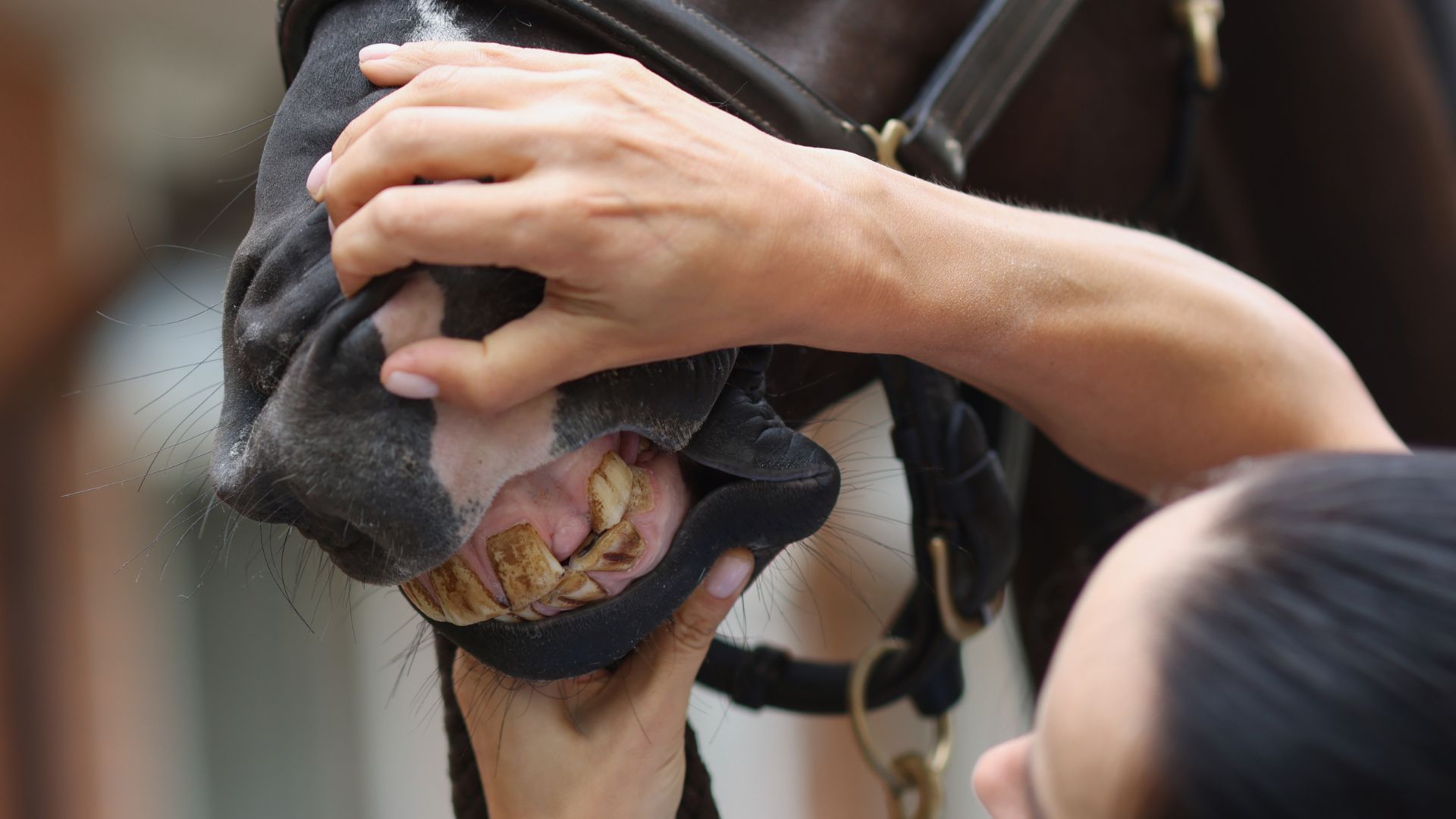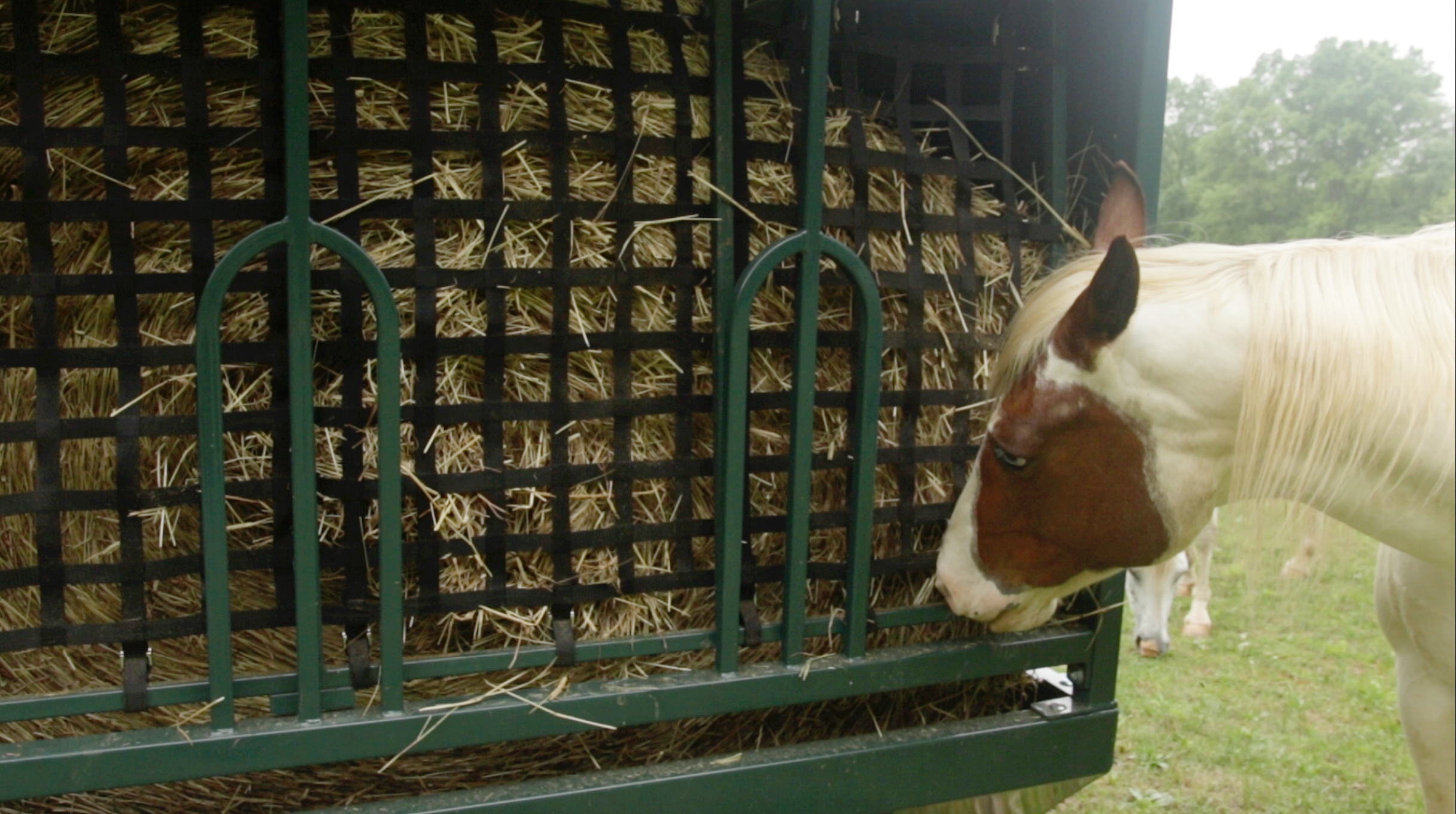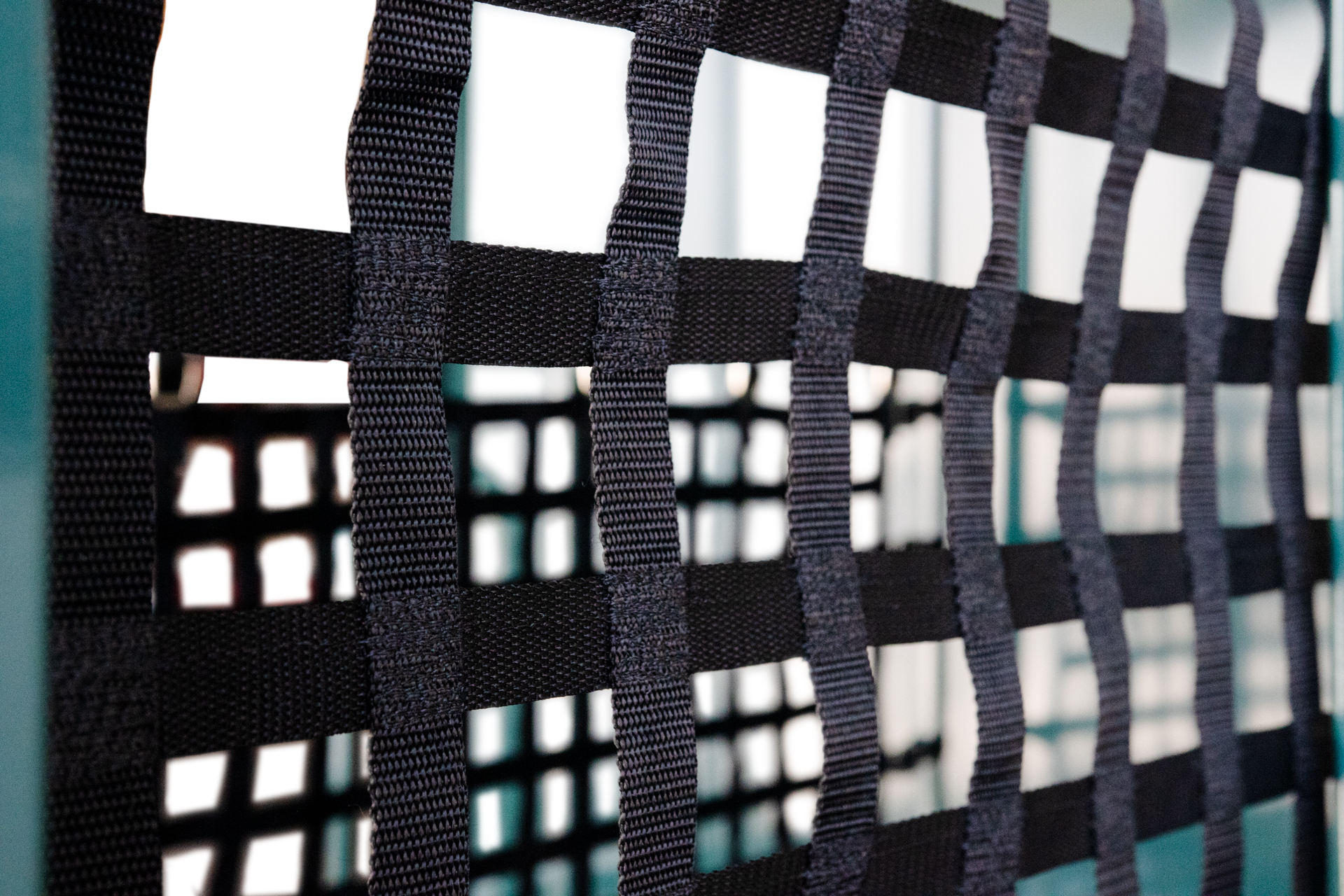Slow feed horse hay feeders have seen a dramatic increase in popularity over the last few decades. And with the clear benefits, it’s no wonder. Reduced hay waste, better equine weight management, and better digestion are just a few of the advantages these feeders offer. If you want to better understand how slow feeders reduce hay waste, click here.
However, like any emerging technology, it’s important to keep an eye out for unintended side effects. In the last few years, various photos and posts have circulated on horse forums, Facebook, and other platforms showing equine dental damage reportedly caused by slow hay feeder use. Reports like these have raised a significant question for concerned horse owners: “Are slow feeders bad for horses’ teeth?”

Contents
Are Slow Feeders Bad for Horses’ Teeth? – The Short Answer
In general, slow hay feeders are not bad for horses’ teeth, as long as the slow feeder design doesn’t include a steel/metal grate. Feeders that do seem to have a higher risk of causing equine dental damage are those which include steel grates or other metal elements between horses’ mouths and their hay. Slow feeders with mesh rope-nets have almost no accounts of damage, while feeders with woven polyester nets (like this one) have no known examples of tooth damage. Before jumping to conclusions, though, let’s look deeper at some of the issues raised.
Dental Concerns Associated with Horse Hay Slow Feeders
There are a number of concerns which have been raised regarding horse hay slow feeders. These include:
Worn teeth
Grooves or other unusual wear patterns caused by the repetitive motion of the horse’s teeth against the feeder surface. This is generally reported with hard-surface feeders, particularly those using metal grates. It’s also been occasionally reported with some mesh/rope-net feeders, although it seems to be rarer.
Chipping or fractures
Damage has been reported on the enamel surface of the horse’s teeth. This could include chipped enamel or fractures to the tooth itself. At worst, there are even a few reports of a tooth broken off completely.
Pulp horn infections
Some veterinarians have reported seeing pulp horn infections which they attributed to certain types of slow hay feeders wearing teeth down too rapidly.
Gum and lip injuries/infections
While, rare, there are reports of lips and gums developing injuries/infections caused by the horse’s gums rubbing against a feeder while trying to pull hay out.
Slow feeders with metal grates seem to be the design that takes most of the blame for these incidents. The general consensus among veterinarians and the majority of horse owners is that the only slow feeders which pose a significant risk of tooth damage are steel grate slow feeders. Additionally, it seems that underlying risk factors can make certain horses more susceptible to tooth damage or other dental maladies…
Other Factors That Contribute to Equine Dental Damage
The question of whether slow hay feeders are bad for horses’ teeth is complicated by the fact that there are numerous other factors that can affect equine dental health. Sometimes the same issues that prompt a slow-feed diet for a horse can also put the horse at a higher risk of dental problems; examples include endocrine disease or stereotypical behaviors. Some risk factors that are known to contribute to dental issues in horses include:
Excessive dentistry
When it comes to horse teeth floating and other dental procedures, it’s definitely possible to have too much of a good thing. Power tools in the hands of an overzealous equine dentist can mean more surface is taken off of a horse’s teeth during routine dental work. One recent study found that excessive dentistry made horses 5x as likely to suffer certain dental diseases. If a horse’s teeth have already been compromised during a dental operation, it may make them more susceptible to additional damage from a poorly constructed slow feeder.
Endocrine disease and laminitis
There is existing evidence that digestive and other health issues may be risk factors toward some types of equine dental problems. While laminitis itself is not known to cause dental issues, there does seem to be some overlap between laminitic horses and those more prone to excessive tooth wear from slow feeders. PPID and EMS, two conditions known to contribute to the onset of laminitis can also double the risk of certain dental conditions in horses. On the other hand, slow feeding is one of the key tools for managing laminitis, so it’s important not to avoid slow feeding for high-risk horses, simply to find the proper feeder and monitor tooth wear.
Alfalfa-only diet
Horses fed on alfalfa hay are roughly 2x as likely to develop some types of dental problems. As most equine lovers already know, a low-mastication, high-sugar diet is a recipe for dental (and digestive) problems in a horse. Even when slow feeding, it’s important to make sure that the hay you choose for your horse has enough fiber and roughage to force the horse to chew it properly. Additionally, if your horse is considered sugar-sensitive, it’s a good idea to have your hay tested for sugar content.
Periodontal disease
One side effect of insufficient mastication (chewing) during feeding is the increased risk of periodontal disease. While periodontal disease is technically a dental disease in its own right, it can also contribute as much as 5x to other dental conditions. If a horse isn’t grazing or doing enough chewing during feeding times, it can result in food packing, bacteria growth, and other nasty things that can contribute to periodontal disease. Thankfully, slow feeding can actually help prevent this by encouraging chewing patterns similar to natural grazing.
Stereotypical behaviors
Negative behaviors like cribbing and chewing on wood/plastic/metal are usually symptoms of an underlying issue. However, these behaviors can be hard on a horse’s teeth. Horses that exhibit these behaviors may also abuse their slow feeders, contributing to dental damage. (More on this below.)
Can A Slow Hay Feeder Actually Improve Equine Dental Health?
There is strong evidence to suggest that slow feeding may actually provide an overall net benefit to horses’ teeth by managing or removing some of the dental risks posed by other underlying conditions. In particular, slow feeders may:
Reduce the risk of periodontal disease
While the disease is thought to be caused by some combination of gingivitis and food compaction due to malocclusion, there’s also evidence that a lack of grazing can contribute. The saliva that is stimulated when a horse grazes is thought to help bathe the teeth and prevent excessive food buildup. Slow feeding helps to mimic some of the benefits of grazing by encouraging horses to ingest a steady stream of forage throughout the day rather than in bulk at feeding times. This may help stimulate saliva production and keep the teeth healthier.
Help control endocrine disease (EMS and PPID)
Slow feeding can help to prevent and/or control some of the dietary problems related to these diseases. When combined with low-sugar hay, slow feeding can help reduce obesity and regulate the horse’s intake of non-structural carbohydrates, both keys to prevention/treatment of laminitis and the underlying diseases that cause it. Not only does properly treating endocrine disease reduce the risk of laminitis, it also protects your horse’s teeth by reducing the risk of other dental problems.
Keep in mind that it’s important to know the sugar levels in the hay you provide to at-risk horses. Sending a hay sample to a forage laboratory is the most accurate way to assess the levels of non-structural carbohydrates in your feed.
Reduce stereotypical behaviors
This is where slow feeders really shine. Stereotypical behaviors that are hard on teeth (like crib biting) are usually triggered by underlying issues. Many of these issues can be reduced through slow feeding. Stereotypical behaviors can be caused by:
Boredom
If a horse doesn’t have enough positive activity, it may turn to negative behavior to occupy itself. A slow feeder gives a healthy outlet for a horse’s energy by allowing it to nibble all day long.
Gastric ulcers
Horses’ digestive systems are designed for constant grazing. In fact, they need a steady stream of eating-induced saliva to buffer the acid naturally produced by their stomachs. When horses go too long between meals, the acid in their stomachs can cause ulcers, which in turn can trigger other negative behavior. A slow feeder keeps them eating steadily and guards horses’ stomachs against ulcers and the side effects they cause.
Stress
Elevated levels of the stress hormone cortisol seem to contribute to stereotypical behaviors. Stress can be caused by numerous factors, but food-related stress is one of the most common. When horses need to wait for periods of time without access to food, they can begin to develop food-related anxiety about their next feeding. This stress can lead to further negative behavior in the horse. With a slow feeder, the constant access to food can help reduce cortisol levels and help prevent poor behavior.
Since crib biting, windsucking, and other “stable vices” are so hard on teeth, alleviating or eliminating them can help to protect the dental health of your horses.
Choosing a Slow Feeder Design to Protect Horses’ Teeth
There is a huge variety of horse feeders available, including numerous slow feed options. So, which slow feeder is best? That’s a large question that deserves its own article, but we can break the different slow feeder types into 5 main categories. Let’s look at which slow feeders provide the greatest protection to horses’ teeth.
Metal slow feeder
These slow feeders are NOT recommended as they’ve been consistently demonstrated to cause tooth damage. Stay away from metal slow feeders; it’s not worth risking your horse’s teeth with so many other good options available.
Hard plastic slow feeder
These feeders, which can be designed as buckets or balls, are much better than metal and are generally considered safe. However, the hard surface does have the potential to wear on teeth over time. If your horse is already at risk of dental issues, you may want to steer clear and choose another type.
Mesh/rope net slow feeder
Whether you’re feeding show horses or retirees, this is one of the most popular and well-known slow feeder designs. They are made from a variety of materials, including nylon and nylon/poly blends, and may feature a knotted or knotless construction in the netting. There is almost no risk of tooth damage with these feeders, although some horse owners have noticed slight grooves in horse teeth after months or years of use.
Rubber slow feeder
While rarer, especially in the United States, some feeders use rubber mesh or “fingers” to trickle feed hay. (This design is better known in the UK.) Soft rubber has virtually zero risks of damaging horse teeth.

Woven polyethylene net slow feeder
Of the horse slow feeder designs popular in the United States, this seems to be the design that may be the best for protecting horses’ teeth. Woven polyethylene net slow feeders are generally fashioned as black nets with square holes, usually in sizes from 1” to 3”. The polyethylene fabric used in these feeders is tough and durable but has not been shown to cause any equine dental damage.
Polyethylene net slow feeders are available in all sizes, from small bags for one flake of hay up to covered slow feeder designs capable of handling an entire large hay bale. Speaking of slow feeders, do you think that a horse can overeat?

The Takeaway
While most slow feeder designs (other than metal) won’t damage equine teeth under normal circumstances, it’s important to monitor your horse’s mouth for changes whenever feeding adjustments are made and to be aware of underlying risk factors that can affect equine dental health.
